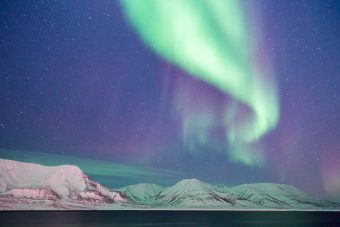Depletion of the ozone layer, the shield that protects life on Earth from harmful levels of ultraviolet radiation, is at an unprecedented level over large parts of the Arctic this spring. This phenomenon is caused by the continuing presence of ozone-depleting substances in the atmosphere and a very cold winter in the stratosphere (the layer of the atmosphere between around 10 km and round 50 km altitude).

Total ozone columns over large parts of the Arctic have reached record-breaking low values this year with a severe ozone depletion at altitudes of around 18 km. The last time similarly strong ozone depletion was observed over the Arctic was during spring 2011, and ozone depletion in 2020 seems on course to be even stronger, according to the Copernicus Atmospheric Monitoring Service implemented by ECMWF.
Actions taken under an international agreement called the Montreal Protocol have led to decreases in the atmospheric abundance of controlled ozone-depleting substances. But their concentrations in the upper atmosphere are still high enough to cause severe ozone destruction. The spring depletion is driven by a combination of factors including low temperatures in the Arctic stratosphere during polar night and the arrival of sunlight in the early spring.
The majority of the ozone depletion in the Arctic takes place inside the so-called polar vortex: a region of fast-blowing circular winds that intensify in the fall and isolate the air mass within the vortex, keeping it very cold. As the meteorological conditions and temperatures are different from year to year, the severity of the ozone depletion also fluctuates. This means that occasional large Arctic ozone depletions are still possible .
The Arctic stratosphere is usually less isolated than the Antarctic one. Stratospheric temperatures in the Arctic usually do not fall as low as in the Antarctic stratosphere neither do they stay low for extended period of time.
However, this winter (2019-2020), the stratospheric polar vortex has been so strong and cold for so long that the temperatures in the Arctic stratosphere have dropped to levels more typical for over Antarctica, creating a large area of polar stratospheric clouds and promoting chemical processes that deplete ozone. Atmospheric conditions blocking wind-driven resupply of ozone from the lower latitudes has also been a factor.
By contrast with the Arctic, the 2019 ozone hole over Antarctica was the smallest on record since the ozone hole was first discovered.
UV Radiation
WMO’s Global Atmosphere Watch Network has stations in the Arctic and these are performing high-quality measurements of both ozone and Ultraviolet (UV) radiation.
The 2020 conditions are similar to the spring of 2011 when the ozone losses over the Arctic were near 50%. The depletion of the Arctic ozone led to an increase in surface UV radiation in the spring of 2011, with scientists observing a 60% increase in the UV Index in the Canadian Arctic, and an even higher increase over Northern Europe.
Moreover, ozone depletion in the Arctic affects the total ozone budget resulting in an increase of summertime UV levels over Canada and Europe. Each year, based on springtime ozone levels, a summer seasonal UV forecast is provided to the public in different countries.
Montreal Protocol
The most recent Scientific Assessment of Ozone Depletion from WMO and the UN Environment Programme shows that the ozone layer in parts of the stratosphere has recovered at a rate of 1-3% per decade since 2000. At projected rates, Arctic and Northern Hemisphere mid-latitude ozone is expected to heal completely before the middle of the century (~2035) followed by the Southern Hemisphere mid-latitude around mid-century, and Antarctic region by 2060.
Without the Montreal Protocol, this year’s ozone destruction would most likely have been worse. Ozone depleting substances such as chlorofluorocarbons (CFCs) and halons, once present in refrigerators, spray cans and fire extinguishers, have been phased out under the Montreal Protocol. Nevertheless, the atmospheric measurements and analysis allowed to detect the renewed emissions of some of the controlled substances, stressing the importance of continuous observations of these constituents.
The slow recovery of the ozone layer is due to the fact that ozone depleting substances stay in the atmosphere for several decades.
Source: WMO



